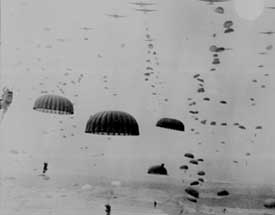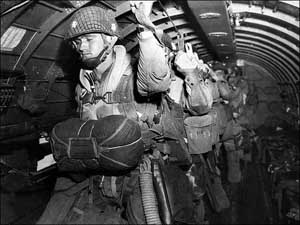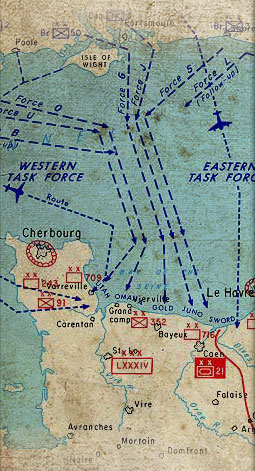
 The airborne landings some distance behind the beaches were also intended to ease the egress of the amphibious forces off the beaches, and in some cases to neutralize German coastal defence batteries and more quickly expand the area of the beachhead. The U.S. 82nd and 101st Airborne Divisions were assigned to objectives west of Utah Beach. The British 6th Airborne Division was assigned to similar objectives on the eastern flank. 530 Free French paratroopers from the British Special Air Service Brigade, were assigned to objectives in Brittany from 5 June to August.(Operation Dingson, Operation Samwest).
The airborne landings some distance behind the beaches were also intended to ease the egress of the amphibious forces off the beaches, and in some cases to neutralize German coastal defence batteries and more quickly expand the area of the beachhead. The U.S. 82nd and 101st Airborne Divisions were assigned to objectives west of Utah Beach. The British 6th Airborne Division was assigned to similar objectives on the eastern flank. 530 Free French paratroopers from the British Special Air Service Brigade, were assigned to objectives in Brittany from 5 June to August.(Operation Dingson, Operation Samwest).
British airborne landings
East of the landing area, the open, flat, floodplain between the Orne and Dives Rivers was ideal for counterattacks by German armour. However, the landing area and floodplain were separated by the Orne River, which flowed northeast from Caen into the bay of the Seine. The only crossing of the Orne River north of Caen was 7 kilometers (4.5 mi) from the coast, near Bénouville and Ranville. For the Germans, the crossing provided the only route for a flanking attack on the beaches from the east. For the Allies, the crossing also was vital for any attack on Caen from the east.
The tactical objectives of the British 6th Airborne Division were (a) to capture intact the bridges of the Bénouville-Ranville crossing, (b) to defend the crossing against the inevitable armoured counter-attacks, (c) to destroy German artillery at the Merville battery, which threatened Sword Beach, and (d) to destroy five bridges over the Dives River to further restrict movement of ground forces from the east.
Airborne troops, mostly paratroopers of the 3rd and 5th Parachute Brigades, including the 1st Canadian Parachute Battalion, began landing after midnight, 6 June and immediately encountered elements of the German 716th Infantry Division. At dawn, the Battle Group von Luck of the 21st Panzer Division counterattacked from the south on both sides of the Orne River. By this time the paratroopers had established a defensive perimeter surrounding the bridgehead. Casualties were heavy on both sides, but the airborne troops held. Shortly after noon, they were reinforced by commandos of the 1st Special Service Brigade.
By the end of D-Day, 6th Airborne had accomplished each of its objectives. For several days, both British and German forces took heavy casualties as they struggled for positions around the Orne bridgehead. For example, the German 346th Infantry Division broke through the eastern edge of the defensive line on 10 June. Finally, British paratroopers overwhelmed entrenched panzergrenadiers in the Battle of Bréville on 12 June. The Germans did not seriously threaten the bridgehead again. 6th Airborne remained on the line until it was evacuated in early September.
American airborne landings
 The U.S. 82nd and 101st Airborne Divisions, numbering 13,000 paratroopers delivered by 12 troop carrier groups of the IX Troop Carrier Command, were less fortunate in completing their main objectives. To achieve surprise, the drops were routed to approach Normandy from the west. Numerous factors affected their performance, the primary of which was the decision to make a massive parachute drop at night (a tactic not used again for the rest of the war). As a result, 45% of units were widely scattered and unable to rally. Efforts of the early wave of pathfinder teams to mark the landing zones were largely ineffective, and the Rebecca/Eureka transponding radar beacons used to guide in the waves of C-47 Skytrains to the drop zones were the main component of a flawed system.
The U.S. 82nd and 101st Airborne Divisions, numbering 13,000 paratroopers delivered by 12 troop carrier groups of the IX Troop Carrier Command, were less fortunate in completing their main objectives. To achieve surprise, the drops were routed to approach Normandy from the west. Numerous factors affected their performance, the primary of which was the decision to make a massive parachute drop at night (a tactic not used again for the rest of the war). As a result, 45% of units were widely scattered and unable to rally. Efforts of the early wave of pathfinder teams to mark the landing zones were largely ineffective, and the Rebecca/Eureka transponding radar beacons used to guide in the waves of C-47 Skytrains to the drop zones were the main component of a flawed system.
Three regiments of 101st Airborne paratroopers were dropped first, between 00:48 and 01:40, followed by the 82nd Airborne's drops between 01:51 and 02:42. Each operation involved approximately 400 C-47 aircraft. Two pre-dawn glider landings brought in anti-tank guns and support troops for each division. On the evening of D-Day two additional glider landings brought in two battalions of artillery and 24 howitzers to the 82nd Airborne. Additional glider operations on 7 June delivered the 325th Glider Infantry Regiment to the 82nd Airborne, and two large supply parachute drops that date were ineffective.
After 24 hours, only 2,500 troops of the 101st and 2,000 of the 82nd were under the control of their divisions, approximating a third of the force dropped. The dispersal of the American airborne troops, however, had the effect of confusing the Germans and fragmenting their response. In addition, the Germans' defensive flooding, in the early stages, also helped to protect the Americans' southern flank.
Paratroopers continued to roam and fight behind enemy lines for days. Many consolidated into small groups, rallied with NCOs or junior officers, and usually were a hodgepodge of men from different companies, battalions, regiments, or even divisions. The 82nd occupied the town of Sainte-Mère-Église early in the morning of 6 June, giving it the claim of the first town liberated in the invasion.






